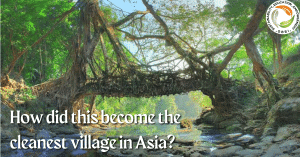Mawlynnong Village, also known as God’s Own Garden, was awarded the title of “The cleanest village in Asia” by Discover India in the year 2003. Not only is this tiny village in India, known for its cleanliness but it is also known for its 100% literacy rate and encourages women empowerment at every scenario.
Mawlynnong is one of the most popular destinations for tourists to visit in Shillong. This village is a community-based matrilineal society where the entire community comes together to make collective efforts and maintain the cleanliness of the village. The village also offers warm welcomes to its visitors with clean roads to travel in, lush green valleys to hike in, and clean water in the rivers to use.
The word “Maw” comes from the Khasi word which means stone and “lynnong” which means scattered. Mawlynnong has scattered large rocks that have natural hollows in them formed due to flowing water in the past.
How did Mawlynnong become the cleanest village in the Asia?
1- Sanitation
The village is known for its cleanliness. Every household has its own bamboo dustbin known as a“khoh” which is used to direct collected waste to a pit which is then used as manure.
Plastic and smoking is banned in the village. Everyone follows rules and defaulters pay heavy fines. Plastic is seen as one of the greatest enemiesin this cleanest village. Every villager comes out on Saturday for a cleanliness drive to pick up all plastics.
2- Tribal Locals
Mawlynnong is majorly inhabited by Khasi Tribe which is the famous tribe that has left behind the patriarchal rule of the society.
They follow matrilineal rule where, children get their mother’s surname and the wealth is passed from the mother to the youngest daughter of the family. This village ensures there is women empowerment and 100% literacy rate.
The locals are hospitable to tourists and environmentally conscious.
3- Living Root Bridges
UNESCO has declared the Living Root Bridges as a World Heritage Site.
The bridge is hanging over a river and was made bythe connecting of aerial roots of one massive rubber tree with the roots of another rubber tree.
An American traveller, Patrick Rogers, documented the existence of 88 of these remarkable and unique architectural structures in 2016. Rogers wrote, “They are practical, but also beautiful; they cost nothing to build, yet can render centuries of effective service; they are ancient, and yet could provide inspiration for dealing with a multitude of 21st Century problems. No other form of architecture becomes naturally stronger over time, but as a root bridge is composed of living elements, so long as part of the tree remains healthy, the structure will self-strengthen and continue to do so indefinitely.“
4- Cleanliness
People not only sweep their own houses, but they also sweep the roads and collect dry leaves from the trees and put them in their bamboo dustbins.
Every household has a natural basin in their front yards for harvesting rainwater.
5- Food
Every food prepared in Mawlynnong is prepared using organically-grown vegetables and in-house bred animals.






